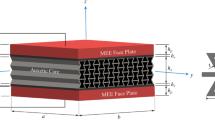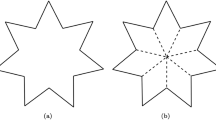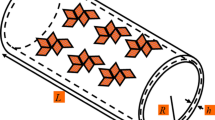Abstract
Designing structures that have minimal or zero coefficients of thermal expansion (CTE) are useful in many engineering applications. Zero thermal expansion is achievable with the design of porous materials. The behavior is primarily stretch-dominated, resulting in favorable stiffness. Two and three-dimensional lattices are designed using ribs consisting of straight tubes containing two nested shells of differing materials. Differential Poisson contraction counteracts thermal elongation. Tubular ribs provide superior buckling strength. Zero expansion is achieved using positive expansion isotropic materials provided axial deformation is decoupled by lubrication or segmentation. Anisotropic materials allow more design freedom. Properties of two-dimensional zero expansion lattices, of several designs, are compared with those of triangular and hexagonal honeycomb nonzero expansion lattices in a modulus-density map. A three-dimensional, zero expansion, octet-truss lattice is also analyzed. Analysis of relative density, mechanical stiffness, and Euler buckling strength reveals high stiffness in stretch-dominated lattices and enhanced strength due to tubular ribs.







Similar content being viewed by others
References
J. Cribb: Shrinkage and thermal expansion of a two phase material. Nature 220, 576–577 (1968).
R.S. Lakes: Cellular solid structures with unbounded thermal expansion. J. Mater. Sci. Lett. 15, 475–477 (1996).
R.S. Lakes: Cellular solids with tunable positive or negative therrmal expansion of unbounded magnitude. Appl. Phys. Lett. 90, 221905 (2007). doi: 10.1063/1.2743951.
L.J. Gibson and M.F. Ashby: Cellular Solids Structure and Properties, 2nd ed., edited by D.R. Clarke, S. Suresh, and I.M. Ward (Cambridge University Press, Cambridge, England, 1997), pp. 15–172.
J.J. Lehman and R.S. Lakes: Stiff lattices with zero thermal expansion. J. Intell. Mater. Syst. Struct. 23(11), 1263–1268 (2012).
J.J. Lehman and R.S. Lakes: Stiff lattices with zero thermal expansion and enhanced stiffness via rib cross section optimization. Int. J. Mech. Mater. Des. (2013, in press), doi: 10.1007/s10999-012-9210-x.
K.M. Baird: Compensation for linear thermal expansion. Metrologia 4(3), 145–146 (1968).
C. Woolger: Invar nickel-iron alloy: 100 years on. Mater. World 4(6), 332–333 (1996).
B.D. Agarwal and L.J. Broutman: Analysis and Performance of Fiber Composites, 2nd ed. (John Wiley & Sons Inc., New York, 1990), p. 105.
ASM International Materials Properties Database Committee: ASM Ready Reference Thermal Properties of Metals (ASM International, Materials Park, OH, 2002), pp. 11–12.
R.D. Cook and W.C. Young: Advanced Mechanics of Materials, 2nd ed. (Prentice Hall Inc., Upper Saddle River, NJ, 1999), pp. i–ii.
K.M. Baird: Thermal expansion compensation device. Canada Patent No. 3,528,206, September 15, 1970.
H. Hunt: The mechanical strength of ceramic honeycomb monoliths as determined by simple experiments. Chem. Eng. Res. Des. 71, 257–265 (1993).
V. Deshpande, N.A. Fleck, and M.F. Ashby: Effective properties of the octet-truss lattice material. J. Mech. Phys. Solids 49, 1747–1769 (2001).
S.P. Timoshenko and J.M. Gere: Theory of Elastic Stability (McGraw-Hill, New York, 1961), pp. 457–463.
Acknowledgment
Support from DARPA-LLNL under the aegis of Dr. Judah Goldwasser is gratefully acknowledged.
Author information
Authors and Affiliations
Corresponding author
Rights and permissions
About this article
Cite this article
Lehman, J., Lakes, R. Stiff, strong zero thermal expansion lattices via the Poisson effect. Journal of Materials Research 28, 2499–2508 (2013). https://doi.org/10.1557/jmr.2013.154
Received:
Accepted:
Published:
Issue Date:
DOI: https://doi.org/10.1557/jmr.2013.154




